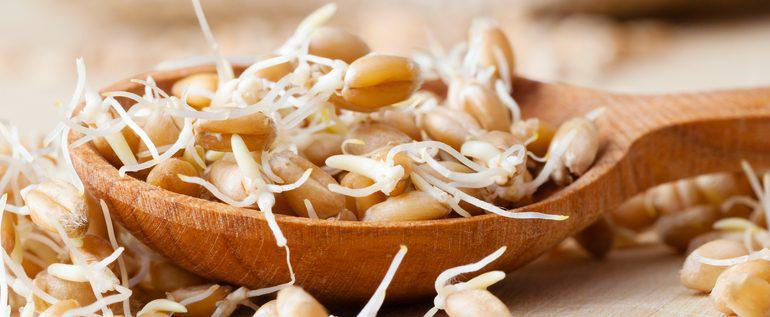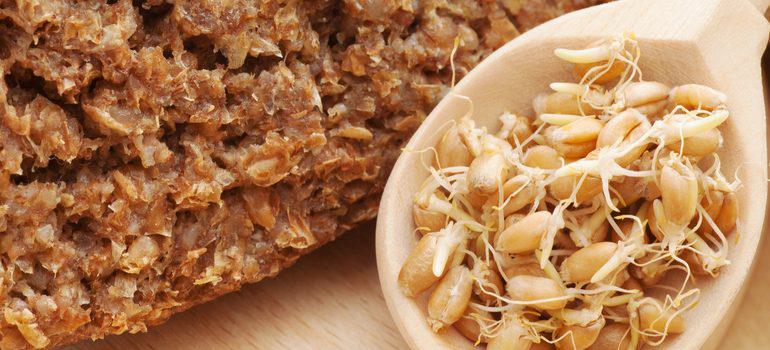


 To understand what sprouted grains are, it is first necessary to understand what a grain is at its most basic level. Grains are the seeds of certain plants that have been cultivated and harvested for food and are largely derived from cereal grasses.
A whole grain is comprised of three main elements: the bran, germ and endosperm, all of which are essential to creating a new plant. The bran is the tough, exterior layer of the grain kernel that protects the seed until it is ready to begin the growth cycle and imparts fiber, trace minerals and B vitamins. The germ of the grain kernel is the part of the grain that is capable of sprouting a new plant. The germ is found inside the seed and helps to provide nourishment. The germ contains vitamins, proteins, minerals, antioxidants and oils. The final portion of the grain kernel is the endosperm, which is also found on the interior of the grain kernel. The endosperm is the starchy portion of the grain that is comprised of carbohydrates and proteins. Since the germ is the plant embryo, it will feed on the starchy endosperm when it grows. Processed grains remove the bran and germ portions of the grain.
Until the grain is ready to grow, it relies on its internal growth inhibitors to keep it from germinating. The seed will be able to detect when the temperature and moisture conditions have reached ideal levels for germination. Once the environment has reached the ideal temperature and moisture conditions, the grain will begin to sprout. Once the grain begins sprouting, the enzyme activity will wipe out the growth inhibitors. In addition to this stage, the grain will transform the endosperm (its starch storage) into simpler molecules. The reason for this transformation is that the simpler molecules are easier to digest for a plant embryo that is growing.
The rise in the consumption of sprouted grains is reliant on the theory that this transformation of the carbohydrates into their more easily digestible form applies to more than just plant embryos. Many people believe that sprouted grains at this stage of the growth process are also much more easily digestible by human beings, because they are in between being a seed and a new plant. This means that they offer all of the benefits and nutrients of a whole grain, while being much more digestible for the human body. In addition to being more digestible, grains that have undergone the sprouting process have an increased amount of vitamins and minerals, potentially making sprouted grains a largely untapped nutrient-dense superfood.
To understand what sprouted grains are, it is first necessary to understand what a grain is at its most basic level. Grains are the seeds of certain plants that have been cultivated and harvested for food and are largely derived from cereal grasses.
A whole grain is comprised of three main elements: the bran, germ and endosperm, all of which are essential to creating a new plant. The bran is the tough, exterior layer of the grain kernel that protects the seed until it is ready to begin the growth cycle and imparts fiber, trace minerals and B vitamins. The germ of the grain kernel is the part of the grain that is capable of sprouting a new plant. The germ is found inside the seed and helps to provide nourishment. The germ contains vitamins, proteins, minerals, antioxidants and oils. The final portion of the grain kernel is the endosperm, which is also found on the interior of the grain kernel. The endosperm is the starchy portion of the grain that is comprised of carbohydrates and proteins. Since the germ is the plant embryo, it will feed on the starchy endosperm when it grows. Processed grains remove the bran and germ portions of the grain.
Until the grain is ready to grow, it relies on its internal growth inhibitors to keep it from germinating. The seed will be able to detect when the temperature and moisture conditions have reached ideal levels for germination. Once the environment has reached the ideal temperature and moisture conditions, the grain will begin to sprout. Once the grain begins sprouting, the enzyme activity will wipe out the growth inhibitors. In addition to this stage, the grain will transform the endosperm (its starch storage) into simpler molecules. The reason for this transformation is that the simpler molecules are easier to digest for a plant embryo that is growing.
The rise in the consumption of sprouted grains is reliant on the theory that this transformation of the carbohydrates into their more easily digestible form applies to more than just plant embryos. Many people believe that sprouted grains at this stage of the growth process are also much more easily digestible by human beings, because they are in between being a seed and a new plant. This means that they offer all of the benefits and nutrients of a whole grain, while being much more digestible for the human body. In addition to being more digestible, grains that have undergone the sprouting process have an increased amount of vitamins and minerals, potentially making sprouted grains a largely untapped nutrient-dense superfood.